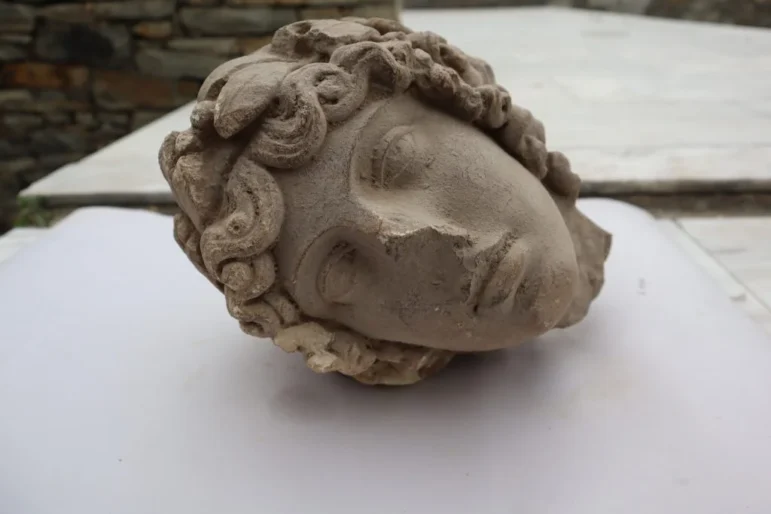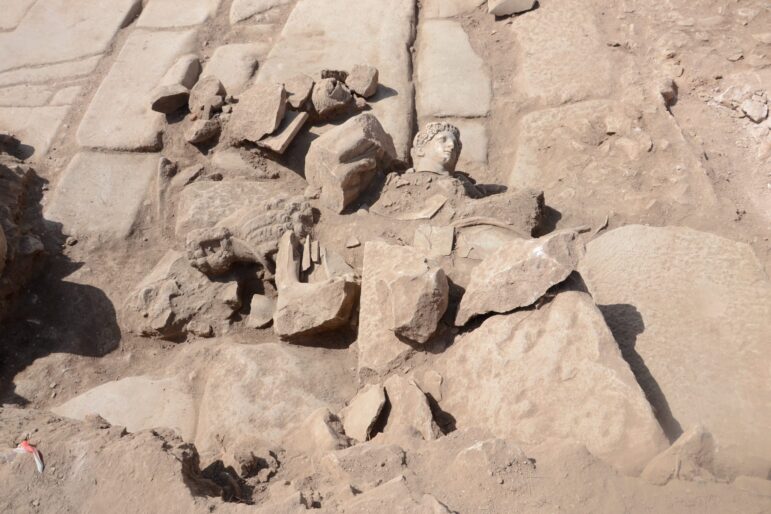
THESSALONIKI, Greece – An archeological expedition conducted by the Aristotle University of Thessaloniki in the ancient settlement of Phillipi has uncovered the marble head of a statue believed to depict the god Apollo, according to a release from the Greek Ministry of Culture and Sports.
Phillipi was originally settled by Thasian colonists around 360 B.C.E. near the head of the Aegean Sea in northern Greece. Originally called Crenides, which means “fountains,” the city was conquered by Philip II of Macedon, father of Alexander the Great, only a few years after its founding and renamed in his honor. The settlement eventually passed into the control of the Roman Empire and survived until sometime in the 14th or 15th centuries C.E. Phillippi was famously the site of a battle between the forces of Octavian (later Augustus Caesar) and Marc Antony against Brutus and Cassius in 42 B.C.E.
The site has been the subject of archeological investigations since 1856, and there have been fruitful excavations in recent years. A fountain uncovered in the ancient town square revealed a largely complete monumental statue of the god Hercules, holding his famous club and lion skin; the same fountain has produced this new find of Apollo.

Head of Apollo from Phillipi [Greek Ministry of Culture and Sports]
Apollo was one of the most popular deities in classical religion, worshiped in both Greek and Roman cultures as the embodiment of a multitude of forces, including music, prophecy, the Sun, and healing, among many others. As the patron deity of the Oracles at Delphi and Delos, Apollo’s cult held significant symbolic and political power during the pagan period.
The statue of Apollo is likely dated to the 2nd or 3rd century C.E., the same as the statue of Hercules, and displays the god with curly hair and a laurel crown – iconography that archeologists have used to identify him. While the divine statues are from the first few centuries of the Common Era, the fountain they seem to have adorned is much later, dating to the 8th or 9th centuries.

Excavation of the statue of Hercules in Phillipi [Greek Ministry of Culture and Sports]
Roman-period statues frequently adorned later Byzantine-era buildings and structures. Since these structures were built deep into the Christian era, it is thought that the statues of pagan gods signified cultural pride and aesthetic beauty more than the devotional functions they had at the time of their creation – though one must wonder if all the putative Christians in the town square of Phillipi never felt any warmth to the old gods they passed on their daily business.
The excavation was led by Natalia Poulou, professor of Byzantine archeology, along with assistant professor of Byzantine Archaeology Anastasios Tantsis, emeritus professor of Byzantine Archaeology Aristotle Mentzos, and 15 graduate and undergraduate students. The excavation will continue next year and promises to unveil more about the continuity between Phillipi’s pagan and Christian periods.
The Wild Hunt is not responsible for links to external content.
To join a conversation on this post:
Visit our The Wild Hunt subreddit! Point your favorite browser to https://www.reddit.com/r/The_Wild_Hunt_News/, then click “JOIN”. Make sure to click the bell, too, to be notified of new articles posted to our subreddit.
